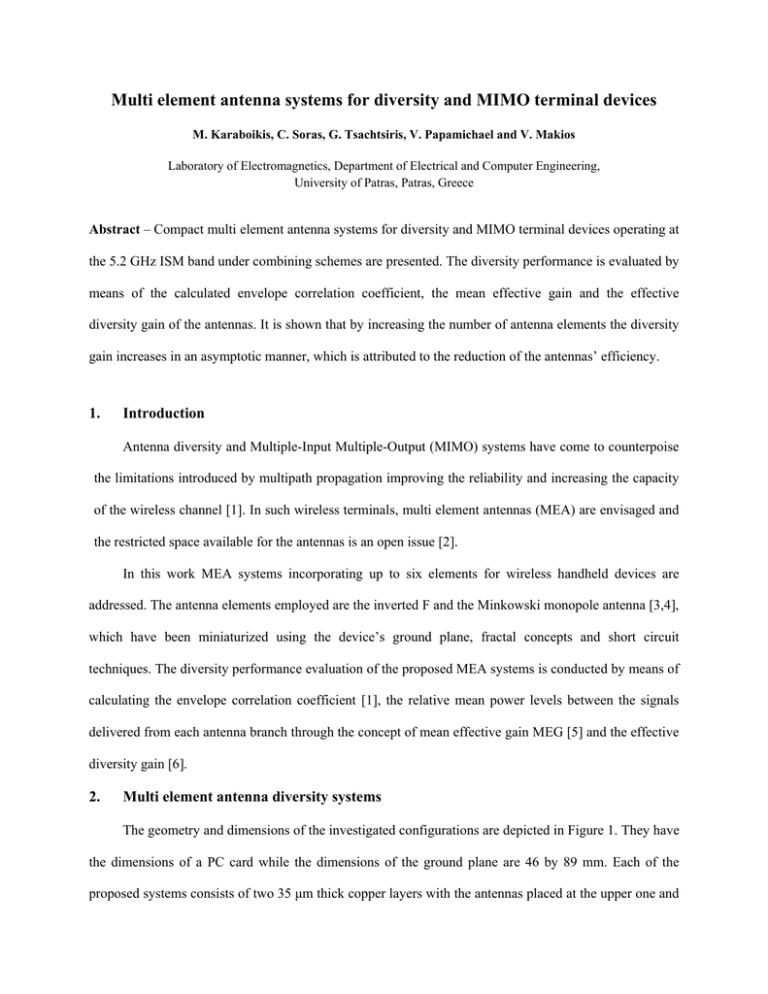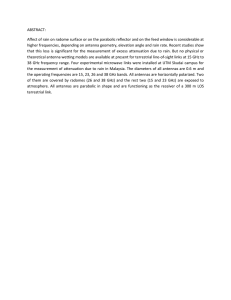Multi element antenna systems for diversity and MIMO
advertisement

Multi element antenna systems for diversity and MIMO terminal devices M. Karaboikis, C. Soras, G. Tsachtsiris, V. Papamichael and V. Makios Laboratory of Electromagnetics, Department of Electrical and Computer Engineering, University of Patras, Patras, Greece Abstract – Compact multi element antenna systems for diversity and MIMO terminal devices operating at the 5.2 GHz ISM band under combining schemes are presented. The diversity performance is evaluated by means of the calculated envelope correlation coefficient, the mean effective gain and the effective diversity gain of the antennas. It is shown that by increasing the number of antenna elements the diversity gain increases in an asymptotic manner, which is attributed to the reduction of the antennas’ efficiency. 1. Introduction Antenna diversity and Multiple-Input Multiple-Output (MIMO) systems have come to counterpoise the limitations introduced by multipath propagation improving the reliability and increasing the capacity of the wireless channel [1]. In such wireless terminals, multi element antennas (MEA) are envisaged and the restricted space available for the antennas is an open issue [2]. In this work MEA systems incorporating up to six elements for wireless handheld devices are addressed. The antenna elements employed are the inverted F and the Minkowski monopole antenna [3,4], which have been miniaturized using the device’s ground plane, fractal concepts and short circuit techniques. The diversity performance evaluation of the proposed MEA systems is conducted by means of calculating the envelope correlation coefficient [1], the relative mean power levels between the signals delivered from each antenna branch through the concept of mean effective gain MEG [5] and the effective diversity gain [6]. 2. Multi element antenna diversity systems The geometry and dimensions of the investigated configurations are depicted in Figure 1. They have the dimensions of a PC card while the dimensions of the ground plane are 46 by 89 mm. Each of the proposed systems consists of two 35 µm thick copper layers with the antennas placed at the upper one and the ground plane at the bottom. The antennas are placed on an 8 mils-thick substrate, with εr=3.38 and tanδ=0.0027. In every case the monopoles are placed on the edge of the device’s ground plane and are terminated to 50-Ω ports. 2 1 2 3 ~ ~ ~ ~ 1 89mm~ ~ ~ ~ Ground Plane 46 mm 3 1 4 3 4 2 ~ ~ 2 1 5 ~ ~ ~ ~ ~ ~ 3.2 mm 5 6 4 3 5.5 mm 2 1 11.7mm 0.5mm ~ ~ ~ ~ 1.5 1.8mm feed short Figure 1. The layouts of the five diversity configurations. The configurations depicted in Figure 1 were simulated using IE3D, a commercial Method of Moments based electromagnetic field solver [7]. In each case the antennas exhibit large bandwidth and are well tuned for the 5.2 GHz ISM band (5.15 – 5.35 GHz) as shown in Figure 2, where the Sii parameters of the six-element case are illustrated. The values of the envelope correlation coefficient ρe shown in Figure 3a indicate that all the antenna branches receive uncorrelated signals since ρe is far below 0.5. This is attributed to the mutual coupling between the closely spaced antenna elements, which plays a key role to the decorrelation mechanism as reported in [1]. The MEG values of each antenna element do not exhibit large differences (2 dB maximum), as depicted in Figure 3b, indicating that the mean power delivered from each antenna branch is nearly the same. Additionally, it can be noticed that the MEG of the elements decrease as the number of antennas increases, which is the major drawback of MEA systems. 0 Sii parameters (dB) -5 -1 0 -1 5 -2 0 S S S S S S -2 5 -3 0 -3 5 1 2 3 4 5 6 1 2 3 4 5 6 -4 0 4 . 5 4 .6 4 . 7 4 .8 4 . 9 5 .0 5 . 1 5 .2 5 . 3 5 .4 5 . 5 5 .6 5 . 7 5 .8 5 . 9 6 .0 F re q u e n cy (G H z) 0.30 0 -1 0.25 -2 -3 0.20 MEG (dBi) Envelope Correlation Coefficient (-) Figure 2. Simulated Sii parameters of the six-element diversity system. 0.15 0.10 -4 -5 -6 -7 0.05 -8 0.00 -10 -9 1 2 3 4 5 Number of elements 6 7 1 2 3 4 5 6 7 Number of elements (a) (b) Figure 3. Simulated envelope correlation coefficients and mean effective gain values of the systems (some values are overlapping) The fulfillment of the diversity criteria (ρe < 0.5 and MEG ratio < 3 dB) ensure that diversity gain is achieved and Figure 4a depicts the effective diversity gain at 1 % outage probability under maximum ratio combining with the six-element case illustrating the highest value (15.1 dB). It is obvious that as the number of antennas increases, the effective diversity gain also increases in an asymptotic manner. The saturation behavior of the diversity gain for the investigated configurations becomes evident after the 5element case, where the increase in gain becomes negligible (0.1 dB). This asymptotic behavior can be attributed to the decrease of the antennas’ efficiency illustrated in Figure 4b, where values far below 60% 16 100 15 90 14 80 13 Efficiency (%) Effective diversity gain (dB) (six element case) are observed. 12 11 10 9 70 60 50 40 8 30 2 3 4 5 Number of elements 6 1 2 3 4 5 6 7 Number of elements (a) (b) Figure 4. (a) Simulated effective diversity gain at 1% outage probability under maximum ratio combining and (b) efficiency of the antenna elements for the different diversity configurations. 3. Conclusion Multi element antenna systems operating in the 5.2 GHz ISM band using the Inverted F and the Minkowski monopole antennas were presented. The diversity criteria are easily fulfilled and the maximum effective diversity gain achieved is 15.1 dB. The observed asymptotic behavior of the diversity gain is attributed to the reduction of the antennas’ efficiency, which occurs when more elements are employed in the same physical space. References [1] [2] [3] [4] [5] [6] [7] R. Vaughan and J. B. Andersen, “Channels, Propagation and Antennas for Mobile Communications”, IEE, London, 2003. D. Gesbert, M. Sha, D. S. Shiu, P. Smith and A. Naguib, “From Theory to Practice: An overview of MIMO space-time coded wireless systems”, IEEE Journal on Selected Areas on Communications, Vol. 21, No. 3, pp. 281-302, April 2003 (special issue on MIMO systems). C. Soras, M. Karaboikis, G. Tsachtsiris and V. Makios, “Analysis and design of an Inverted F antenna printed on a PCMCIA card for the 2.4 GHz ISM band”, IEEE Antennas and Propagation Magazine, Vol. 44, pp. 37-44, February 2002. G. Konstantatos, C. Soras, G. Tsachtsiris, M. Karaboikis and V. Makios, “Finite Element modeling of Minkowski Monopole Antennas Printed on Wireless Devices”, to appear in the Electromagnetics Journal. T. Taga, “Analysis for Mean Effective Gain for Mobile in Land Mobile Radio Environments”, IEEE Transactions on Vehicular Technology, Vol. 28, pp. 117-131, May 1990. P. S Kildal, K. Rosengren, J. Byun and J. Lee, “Definition of effective diversity gain and how to measure it in a reverberation chamber”, Microwave and Optical Technology Letters, Vol. 34, No. 1, pp. 56-59, July 5 2002. Zeland Software Inc., IE3D, http://www.zeland.com/

![EEE 443 Antennas for Wireless Communications (3) [S]](http://s3.studylib.net/store/data/008888255_1-6e942a081653d05c33fa53deefb4441a-300x300.png)
